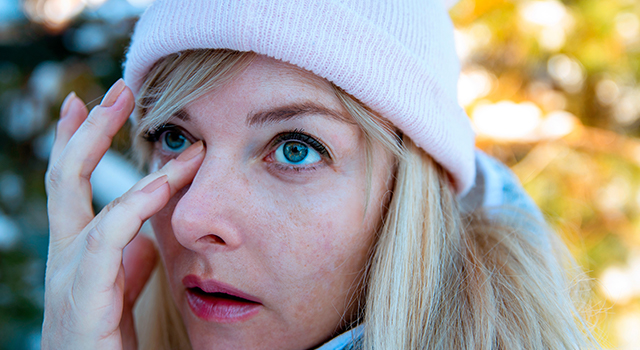
Whether you live in a climate with cold winter weather or you are planning a ski trip up north, winter can be a challenge if you suffer from dry eyes. Dry, cool air, cold winds and even drier indoor heating can cause eye irritation, burning, itchiness and redness, and sometimes even excessively watery eyes as more tears are produced to compensate for the dryness. Many people have a chronic feeling that they have something in their eye and some even experience blurred vision. These symptoms can be debilitating!
Dry eyes is one of the most common complaints eye doctors get from patients during the winter season, especially in the cooler climates. That’s why we’d like to share some tips on how to relieve dry eye discomfort, and how to know when your condition is serious enough to come in for an evaluation.
Tips to Relieve Winter Dry Eyes:
Keep eyes moist using artificial tears or eye drops. You can apply these a few times each day when the eyes are feeling dry or irritated. If over-the-counter drops don’t help or if you have chronic dry eyes, speak to your eye doctor about finding the best drops for you. Since not all artificial tears are the same, knowing the cause of your dry eye will help your eye doctor determine which brand is best suited for your eyes.
Use a humidifier to counteract the drying effects of indoor heaters or generally dry air.
Point car vents or indoor heaters away from your face when the heat is on. Try to keep your distance from direct sources of heating, especially if they blow out the heat.
Drink a lot! Hydrating your body will also hydrate your eyes.
Protect your eyes outdoors with sunglasses or goggles – the bigger the better! Larger, even wrap-around glasses as well as a hat with a wide brim will keep the wind and other elements out of your eyes. If you wear goggles for winter sports, make sure they fit well and cover a large surface area.
Soothe dry eyes using a warm compress and never rub them! Rubbing your eyes will increase irritation and may lead to infection if the hands are not clean.
Give your eyes a digital break. People blink less during screen time which is why extensive computer use can lead to dry eyes. Follow the 20/20/20 rule by taking a break every 20 minutes to look 20 feet away for 20 seconds and make sure you blink!
For contact lens wearers: If you wear contact lenses, dry eyes can be particularly debilitating as the contact lenses can cause even further dryness and irritation. Contact lens rewetting drops can help your eyes feel better and may also allow you to see more clearly. Not all eyedrops are appropriate for use with contact lenses, so ask your optometrist which eyedrop is compatible with your contacts and cleaning solution. If rewetting drops don’t help, consider opting for glasses when your dry eyes are bad, and speak to your optometrist about which brands of contact lenses are better for dry eyes. Many people find dry eye improvement when they switch to daily single use contact lenses.
Chronic Dry Eyes or Dry Eye Syndrome
Dry eye syndrome is a chronic condition in which the eyes do not produce enough tear film, or do not produce the quality of tear film needed to properly keep the eyes moist. While winter weather can make this condition worse, it is often present all year round. If you find that the tips above do not alleviate your discomfort or symptoms, it may be time to see a optometrist to see if your condition requires more effective medical treatment.































